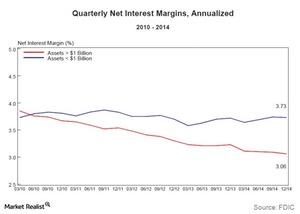Why Lower Funding Costs Impact Net Interest Margins
Lower funding costs determine a bank’s net interest margin. A bank has funding cost advantage when it pays less interest on borrowed funds and deposits.
April 1 2015, Updated 10:06 a.m. ET

Net Interest Margins
Net interest margin (or NIM) is net interest income expressed as a percentage of total interest earning assets. It is the single most followed metric used to assess a bank’s performance in terms of deployment of funds and their cost.
Funding costs impact NIMs
Lower funding costs is one of the key factors that determine a bank’s net interest margin. A bank has a funding cost advantage when it pays less interest on borrowed funds and deposits compared to other banks. This directly improves NIM.
Among the bigger banks, U.S. Bancorp (USB) and Wells Fargo (WFC) have higher NIMs compared to Citigroup (C), Bank of America (BAC), and JP Morgan (JPM). This is partly because U.S. Bancorp and Wells Fargo are more focused on traditional banking activities. Together, these two banks form ~11% of the Financial Select Sector SPDR ETF (XLF).
Deposits make up a higher percentage of total funding for these banks. Since deposits are the cheapest source of funds, the interest margins for these banks are higher. Bigger banks fund a comparatively greater percentage of their operations through secured or unsecured debt.
Big banks focus on fee-based business
The graph above compares annualized interest margins for large and small banks. Small banks, focused on core banking activities, typically have higher NIMs compared to larger banks.
After the economic crisis, larger banks began shying away from certain low-margin, higher-risk activities such as mortgage loans. Instead, they focused on fee-based sources in order to boost income. Thus, margins on interest-bearing assets, or NIMs, have a greater impact on larger banks than on smaller ones.
Interest rate environment impacts interest income
A bank earns interest on outstanding loans. It also earns interest on short-term and long-term investments. Interest income, which forms a major chunk of a bank’s total income, is dependent on two key factors: the volume of loans and the prevailing interest rate.
A bank pays interest on deposits and borrowed funds. Interest expense for a bank thus depends on the amount of deposits and the prevailing interest rate.
